Thermal Characterizations of a Lithium Titanate Oxide-Based Lithium-Ion Battery Focused on Random and Periodic Charge-Discharge Pulses
Abstract
1. Introduction
2. Experimental
3. Result
4. Conclusions
Author Contributions
Funding
Data Availability Statement
Acknowledgments
Conflicts of Interest
References
- Ritchie, A.; Howard, W. Recent developments and likely advances in lithium-ion batteries. J. Power Sources 2006, 162, 809–812. [Google Scholar] [CrossRef]
- Malik, M.; Dincer, I.; Rosen, M.A. Review on use of phase change materials in battery thermal management for electric and hybrid electric vehicles. Int. J. Energy Res. 2016, 40, 1011–1031. [Google Scholar] [CrossRef]
- Hannan, M.A.; Hoque, M.M.; Mohamed, A.; Ayob, A. Review of energy storage systems for electric vehicle applications: Issues and challenges. Renew. Sustain. Energy Rev. 2017, 69, 771–789. [Google Scholar] [CrossRef]
- Chauque, S.; Olivia, F.Y.; Visintin, A.; Barraco, D.; Leiva, O.R.; Camara, E.P.M. Lithium titanate as anode material for lithium ion batteries: Synthesis, posttreatment and its electrochemical response. J. Electroanal. Chem. 2017, 799, 142–155. [Google Scholar] [CrossRef]
- Farmann, A.; Waag, W.; Sauer, D.U. Application-specific electrical characterization of high power batteries with lithium titanate anodes for electric vehicles. Energy 2016, 112, 294–306. [Google Scholar] [CrossRef]
- Kim, J.; Oh, J.; Lee, H. Review on battery thermal management system for electric vehicles. Appl. Therm. Eng. 2019, 149, 192–212. [Google Scholar] [CrossRef]
- Zhang, L.; Peng, H.; Ning, Z.; Mu, Z.; Sun, C. Comparative Research on RC Equivalent Circuit Models for Lithium-Ion Batteries of Electric Vehicles. Appl. Sci. 2017, 7, 1002. [Google Scholar] [CrossRef]
- Zhang, S.S.; Xu, K.; Jow, T.R. The low temperature performance of li-ion batteries. J. Power Sources 2003, 115, 137–140. [Google Scholar] [CrossRef]
- Choi, S.S.; Lim, H. Factors that affect cycle-life and possible degradation mechanisms of a Li-ion cell based on LiCoO2. J. Power Sources 2002, 111, 130–136. [Google Scholar] [CrossRef]
- Andre, D.; Meiler, M.; Steiner, K.; Wimmer, C.; Soczka-Guth, T.; Sauer, D.U. Characterization of high-power lithium ion batteries by electrochemical impedance spectroscopy. I. experimental investigation. J. Power Sources 2011, 196, 5334–5341. [Google Scholar] [CrossRef]
- Pals, C.R.; Newman, J. Thermal modeling of lithium/polymer battery. I. discharge behavior of a single cell. J. Electrochem. Soc. 1995, 142, 3274–3281. [Google Scholar] [CrossRef]
- Hall, F.; Touzri, J.; Wußler, S.; Buqa, H.; Bessler, W.G. Experimental investigation of the thermal and cycling behavior of a lithium titanate-based lithium-ion pouch cell. J. Energy Storage 2018, 17, 109–117. [Google Scholar] [CrossRef]
- Pesaran, A.A.; Burch, S.D. Thermal Performance of EV and HEV Battery Modules and Packs Prepared under FWP HV71. Fourteenth Int. Electr. Veh. Sump. 1997, 7, 997. [Google Scholar]
- Mariani, A.; D’Annibale, F.; Boccardi, G.; Celata, G.P.; Menale, C.; Bubbico, R.; Vellucci, F. Qualitative thermal characterization and cooling of lithium batteries for electric vehicles. J. Phys. Conf. Ser. 2014, 501, 1. [Google Scholar] [CrossRef]
- Zhao, J.C.; Liu, S.H.; Zhang, J.F. Personalized distance learning system based on sequence analysis algorithm. Int. J. Online Eng. 2015, 11, 33–36. [Google Scholar] [CrossRef][Green Version]
- Wu, B.; Li, Z.; Zhang, J.; Huang, J.; Nie, Z.; Sun, Y.; An, F.; Wu, N. Thermal modelling of large-format laminated Li-ion battery and experimental validation using embedded thermocouples. In Proceedings of the 2013 World Electric Vehicle Symposium and Exhibition (EVS27), Barcelona, Spain, 17–20 November 2013; Volume 1, pp. 1–9. [Google Scholar]
- Wang, Q.; Ping, P.; Zhao, X.; Chu, G.; Sun, J.; Chen, C. Thermal runaway caused Fire and explosion of lithium ion battery. J. Power Sources 2012, 208, 210–224. [Google Scholar] [CrossRef]
- Lu, L.; Han, X.; Li, J.; Hua, J.; Ouyang, M. A review on the key issues for lithium-ion battery management in electric vehicles. J. Power Sources 2013, 226, 272–288. [Google Scholar] [CrossRef]
- TLu, Y.; Chiang, C.C.; Wu, S.H.; Chen, K.C.; Lin, S.J.; Wen, C.Y.; Shu, C.M. Thermal hazard evaluations of 18650 lithium-ion batteries by an adiabatic calorimeter. J. Therm. Anal. Calorim. 2013, 114, 1083–1088. [Google Scholar]
- Bhide, S.; Shim, T. Novel Predictive Electric Li-Ion Battery Model Incorporating Thermal and Rate Factor Effects. IEEE Trans. Veh. Technol. 2011, 60, 819–829. [Google Scholar] [CrossRef]
- Zhao, X.W.; Zhang, G.Y.; Yang, L.; Qiang, J.X.; Chen, Z.Q. A new charging mode of batteries with LiFePO4/C composites under low temperature. J. Therm. Anal. Calorim. 2011, 104, 561–567. [Google Scholar] [CrossRef]
- Fleckenstein, M.; Bohlen, O.; Roscher, M.; Baker, B. Current density and state of charge inhomogeneities in li-ion battery cells with lifepo4 as cathode material due to temperature gradients. J. Power Sources 2011, 196, 4769–4778. [Google Scholar] [CrossRef]
- Kameyama, H.; Hanamoto, T.; Ito, K.; Inui, Y.; Onda, K. Study on heat generation behavior of small lithium ion secondary battery. IEEE Trans. Energy Convers. 2001, 112, 1192–1199. [Google Scholar]
- Onda, K.; Kameyama, H.; T, H.; Ito, K. Experimental study on the heat generation behavior of small lithium-ion secondary batteries. J. Electrochem. Soc. 2003, 150, A285. [Google Scholar] [CrossRef]
- Karlsen, L.G.; Villadsen, J. Isothermal reaction calorimeters—I. A literature review. Chem. Eng. Sci. 1987, 42, 1153–1164. [Google Scholar] [CrossRef]
- Cohen, R.; Melman, A.; Livne, N.; Peled, E. Heat Generation in Lithium-Thionyl Chloride and Lithium-SO2 Cells. J. Electrochem. Soc. 1992, 139, 2386–2391. [Google Scholar] [CrossRef]
- Kobayashi, Y.; Miyashiro, H.; Kumai, K.; Takei, K.; Iwahori, T.; Uchida, I. Precise Electrochemical Calorimetry of LiCoO2/Graphite Lithium-Ion Cell. J. Electrochem. Soc. 2002, 149, A978. [Google Scholar] [CrossRef]
- Sherfey, J.M. Calorimetric Determination of Half-Cell Entropy Changes. J. Electrochem. Soc. 1963, 110, 213. [Google Scholar] [CrossRef]
- Chen, S.C.; Wan, C.C.; Wang, Y.Y. Thermal analysis of lithium-ion batteries. J. Power Sources 2005, 140, 111–124. [Google Scholar] [CrossRef]
- Madani, S.S.; Schaltz, E.; Kær, K.S. An experimental analysis of entropic coefficient of a lithium titanate oxide battery. Energies 2019, 12, 2685. [Google Scholar] [CrossRef]
- Madani, S.S.; Schaltz, E.; Kær, S.K. Investigation of the Effect of State-of-Charge and C-Rates on the Heat Loss and Efficiency of a Lithium-Ion Battery. ECS Trans. 2018, 87, 51–58. [Google Scholar] [CrossRef]
- Madani, S.S.; Schaltz, E.; Kær, S.K. Thermal Modelling of a Lithium Titanate Oxide Batt. ECS Trans. 2018, 87, 315–326. [Google Scholar] [CrossRef]
- Madani, S.S.; Schaltz, E.; Kær, S.K. Study of temperature impacts on a lithium-ion battery thermal behaviour by employing isothermal calorimeter. ECS Trans. 2018, 87, 295–305. [Google Scholar] [CrossRef]
- Madani, S.S.; Schaltz, E.; Kær, S.K. Heat Loss Measurement of Lithium Titanate Oxide Batteries under Fast Charging Conditions by Employing Isothermal Calorimeter. Batteries 2018, 4, 59. [Google Scholar] [CrossRef]
- Vertiz, G.; Oyarbide, M.; Macicior, H.; Miguel, O.; Cantero, I.; de Arroiabe, P.F.; Ulacia, I. Thermal characterization of large size lithium-ion pouch cell based on 1d electro-thermal model. J. Power Sources 2014, 272, 476–484. [Google Scholar] [CrossRef]
- Nieto, N.; Díaz, L.; Gastelurrutia, J.; Alava, I.; Blanco, F.; Ramos, J.C.; Rivas, A. Thermal Modeling of Large Format Lithium-Ion Cells. J. Electrochem. Soc. 2013, 160, A212–A217. [Google Scholar] [CrossRef]
- Eddahech, A.; Briat, O.; Vinassa, J.M. Thermal characterization of a high-power lithium-ion battery: Potentiometric and calorimetric measurement of entropy changes. Energy 2013, 61, 432–439. [Google Scholar] [CrossRef]
- Abdul-Quadir, Y.; Laurila, T.; Karppinen, J.; Jalkanen, K.; Vuorilehto, K.; Skogström, L.; Paulasto-Kröckel, M. Heat generation in high power prismatic Li-ion battery cell with LiMnNiCoO2 cathode material. Int. J. Energy Res. 2014, 38, 1424–1437. [Google Scholar] [CrossRef]
- Xiao, M.; Choe, S.Y. Theoretical and experimental analysis of heat generations of a pouch type LiMn2O4/carbon high power Li-polymer battery. J. Power Sources 2013, 241, 46–55. [Google Scholar] [CrossRef]
- Gümüşsu, E.; Ekici, Ö.; Köksal, M. 3-D CFD modeling and experimental testing of thermal behavior of a Li-Ion battery. Appl. Therm. Eng. 2017, 120, 484–495. [Google Scholar] [CrossRef]
- Drake, S.J.; Martin, M.; Wetz, D.; Ostanek, J.K.; Miller, S.; Heinzel, J.; Jain, A. Heat generation rate measurement in a Li-ion cell at large C-rates through temperature and heat flux measurements. J. Power Sources 2015, 285, 266–273. [Google Scholar] [CrossRef]
- Du, S.; Lai, Y.; Ai, L.; Ai, L.; Cheng, Y.; Tang, Y.; Jia, M. An investigation of irreversible heat generation in lithium ion batteries based on a thermo-electrochemical coupling method. Appl. Therm. Eng. 2017, 121, 501–510. [Google Scholar] [CrossRef]
- Zhao, R.; Gu, J.; Liu, J. An investigation on the significance of reversible heat to the thermal behavior of lithium ion battery through simulations. J. Power Sources 2014, 266, 422–432. [Google Scholar] [CrossRef]
- Arora, S.; Shen, W.; Kapoor, A. Critical analysis of open circuit voltage and its effect on estimation of irreversible heat for Li-ion pouch cells. J. Power Sources 2017, 350, 117–126. [Google Scholar] [CrossRef]
- Manikandan, B.; Yap, C.; Balaya, P. Towards understanding heat generation characteristics of Li-Ion batteries by calorimetry, impedance, and potentiometry studies. J. Electrochem Soc. 2017, 164, A2794–A2800. [Google Scholar] [CrossRef]
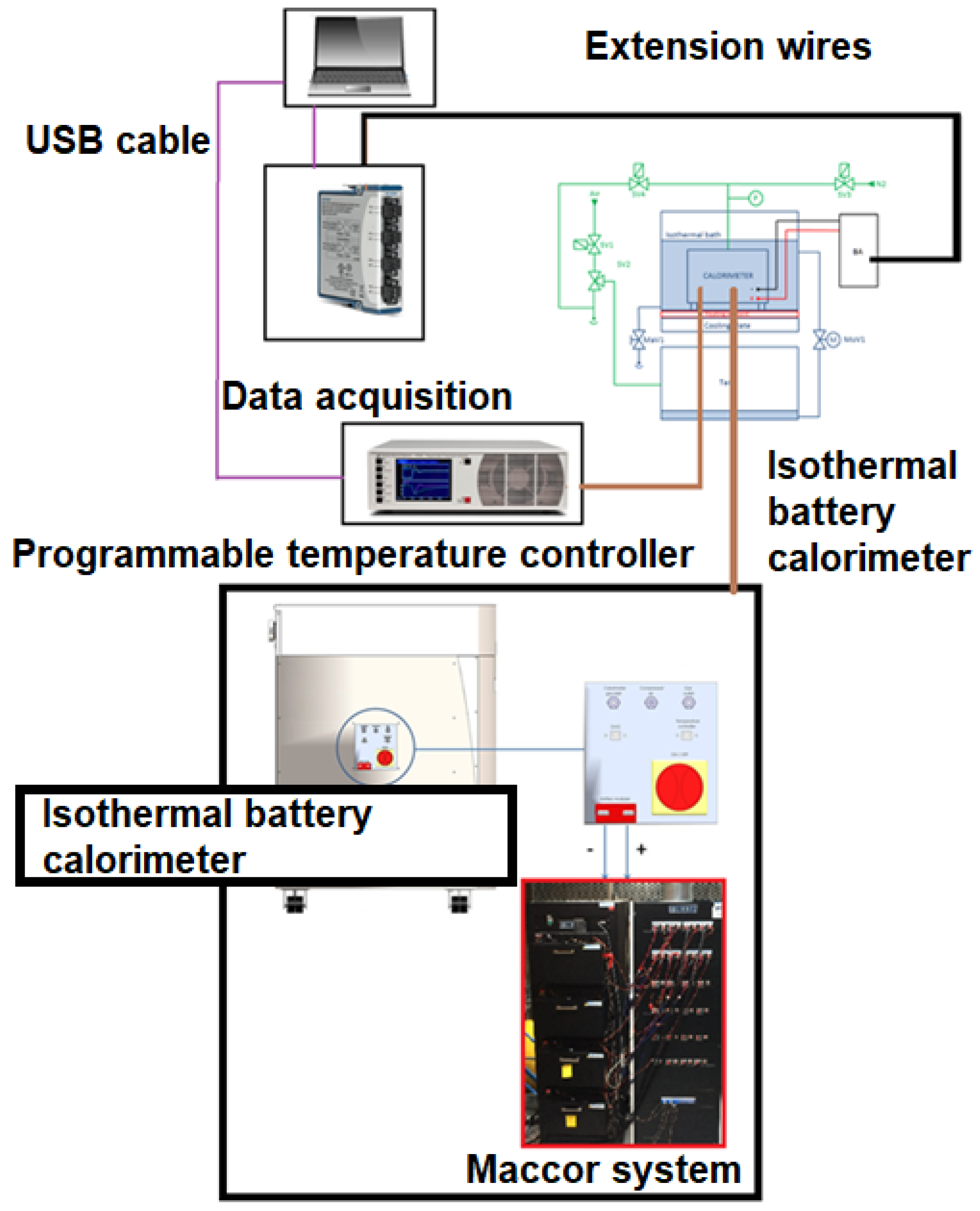
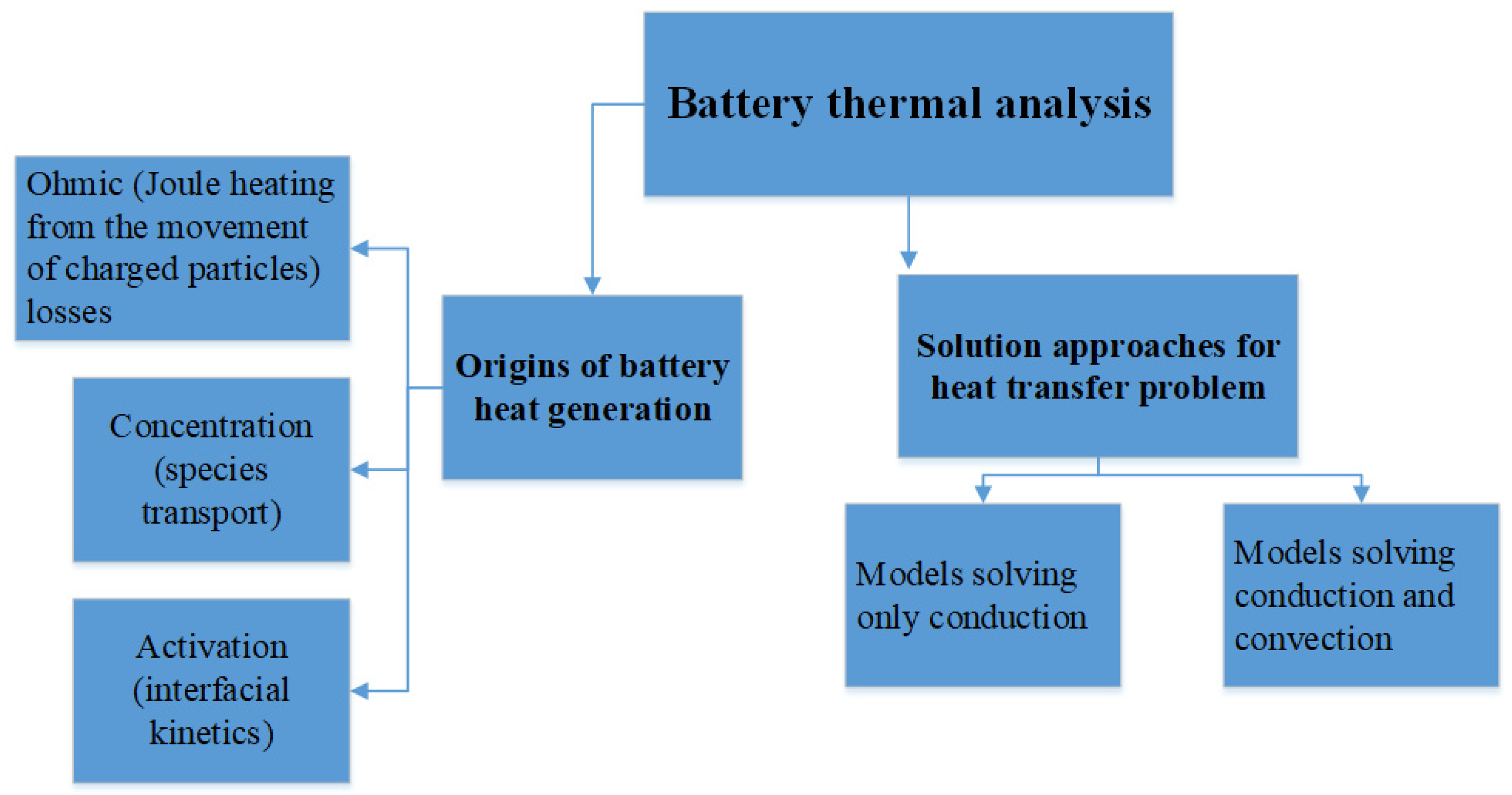
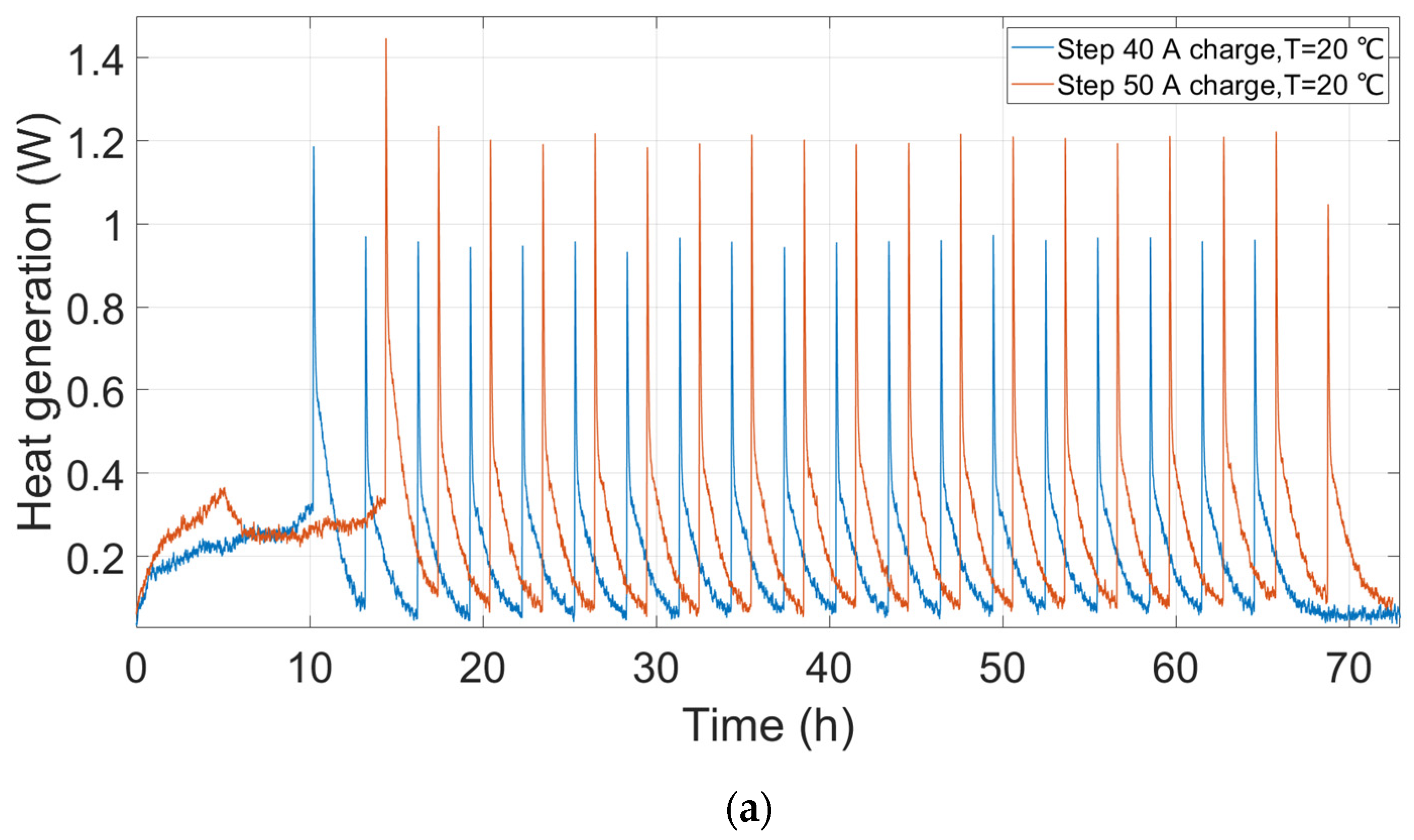
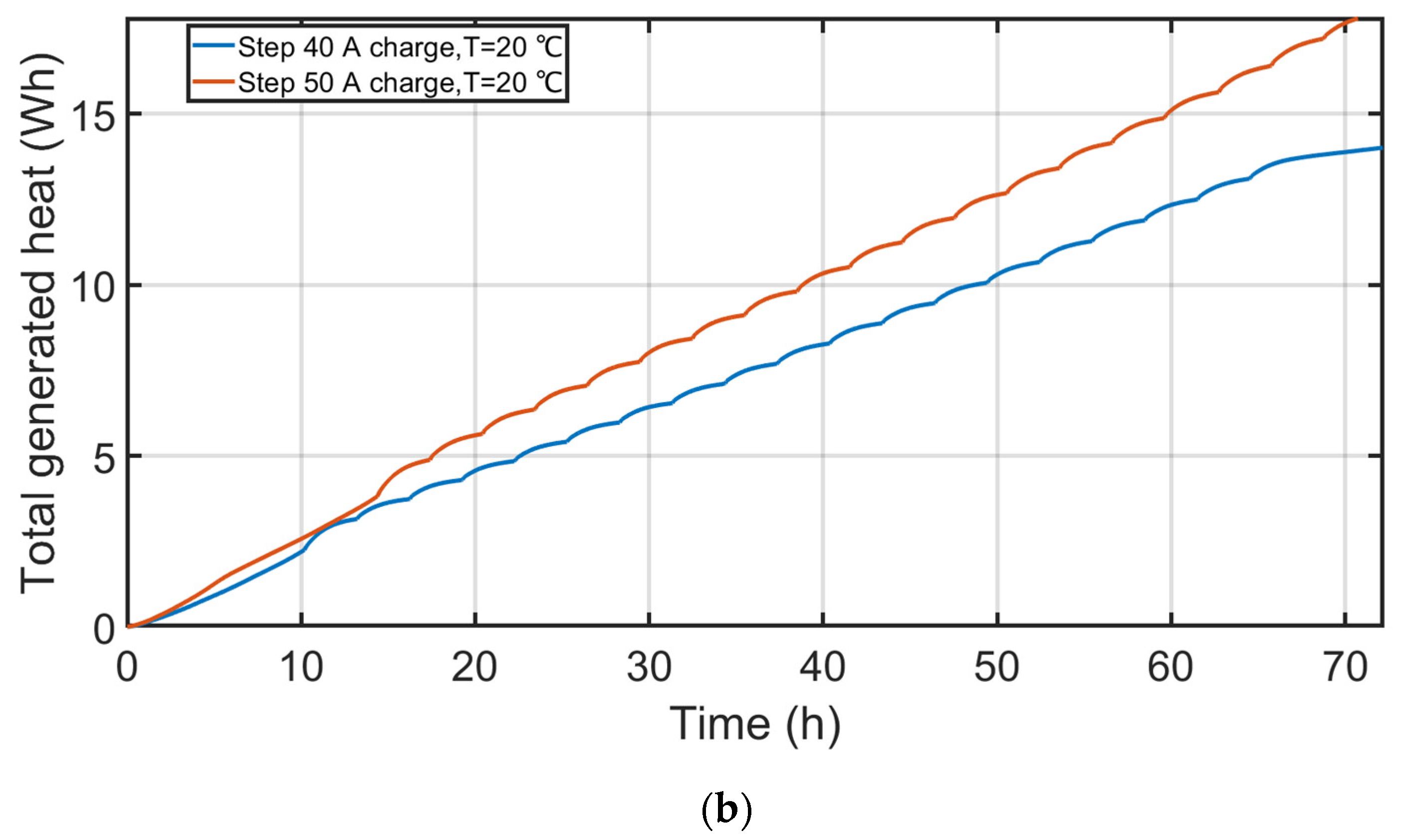
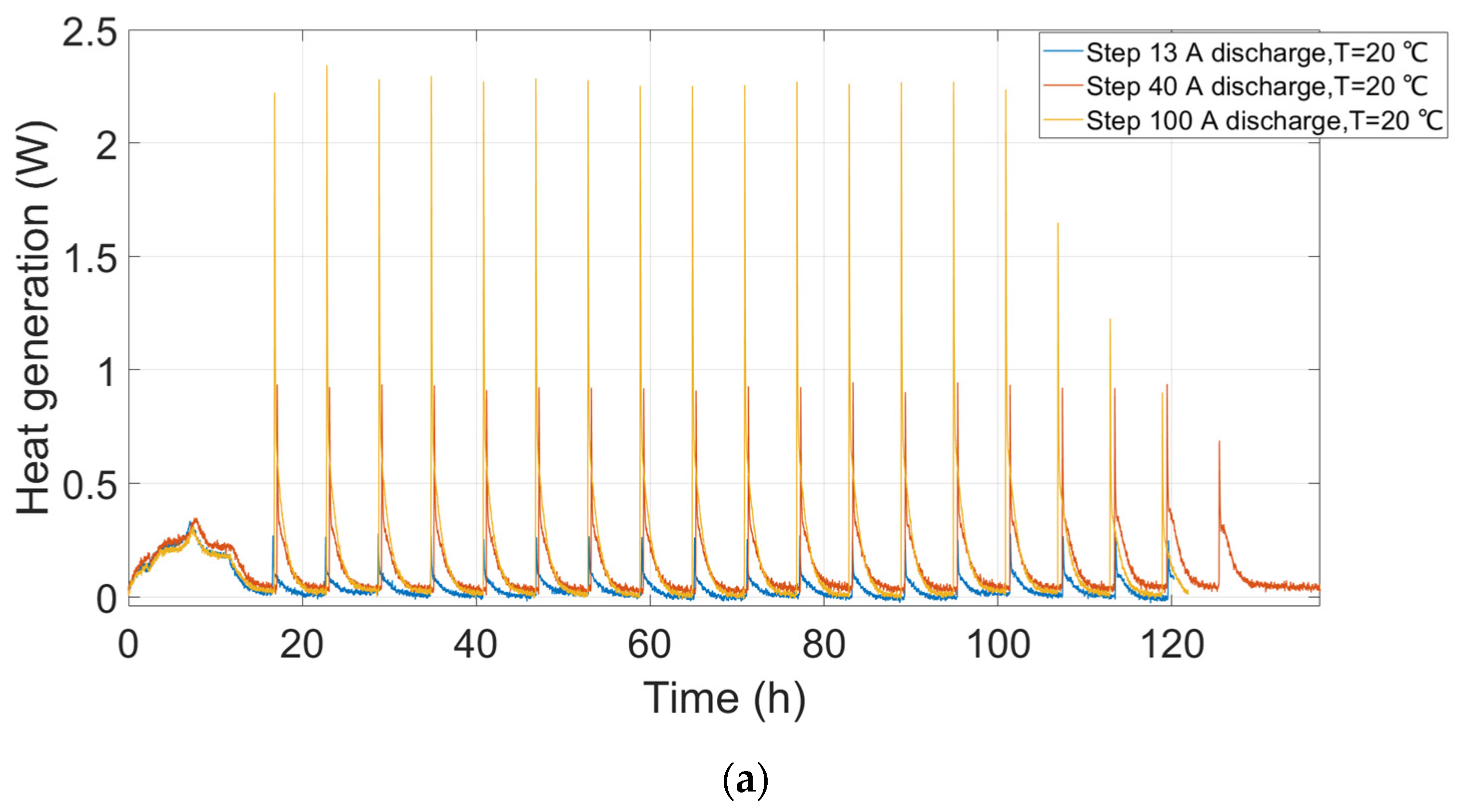
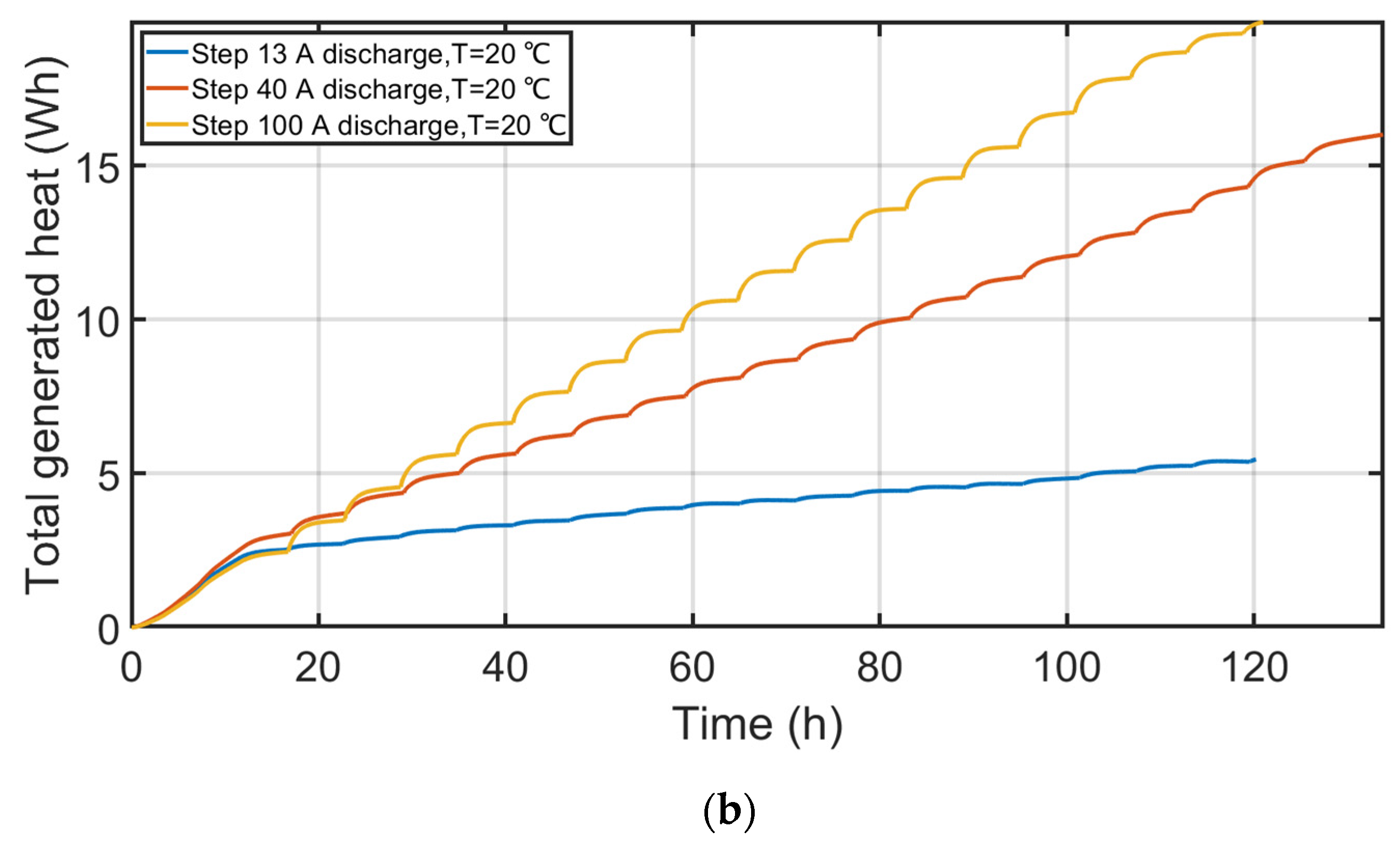
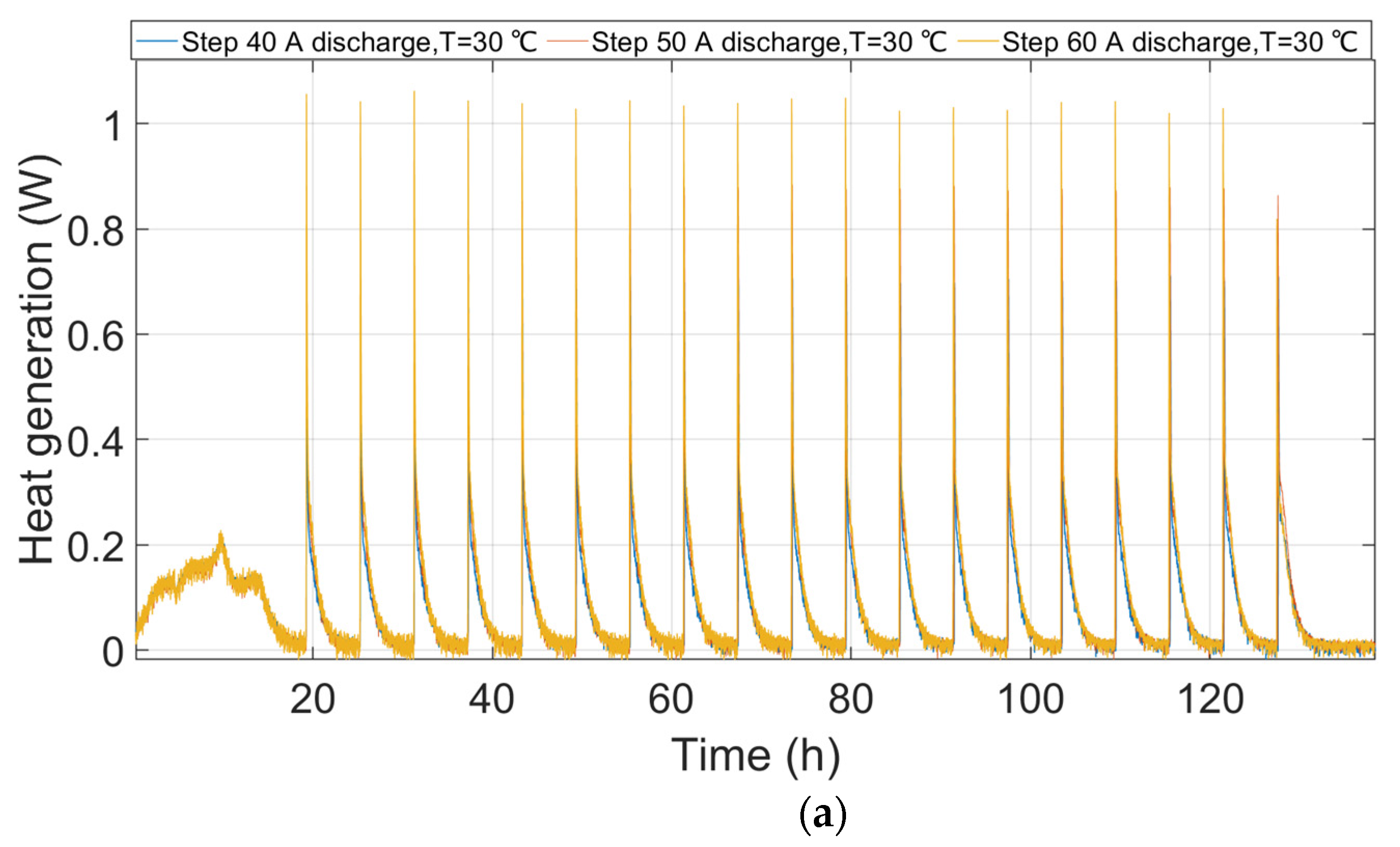
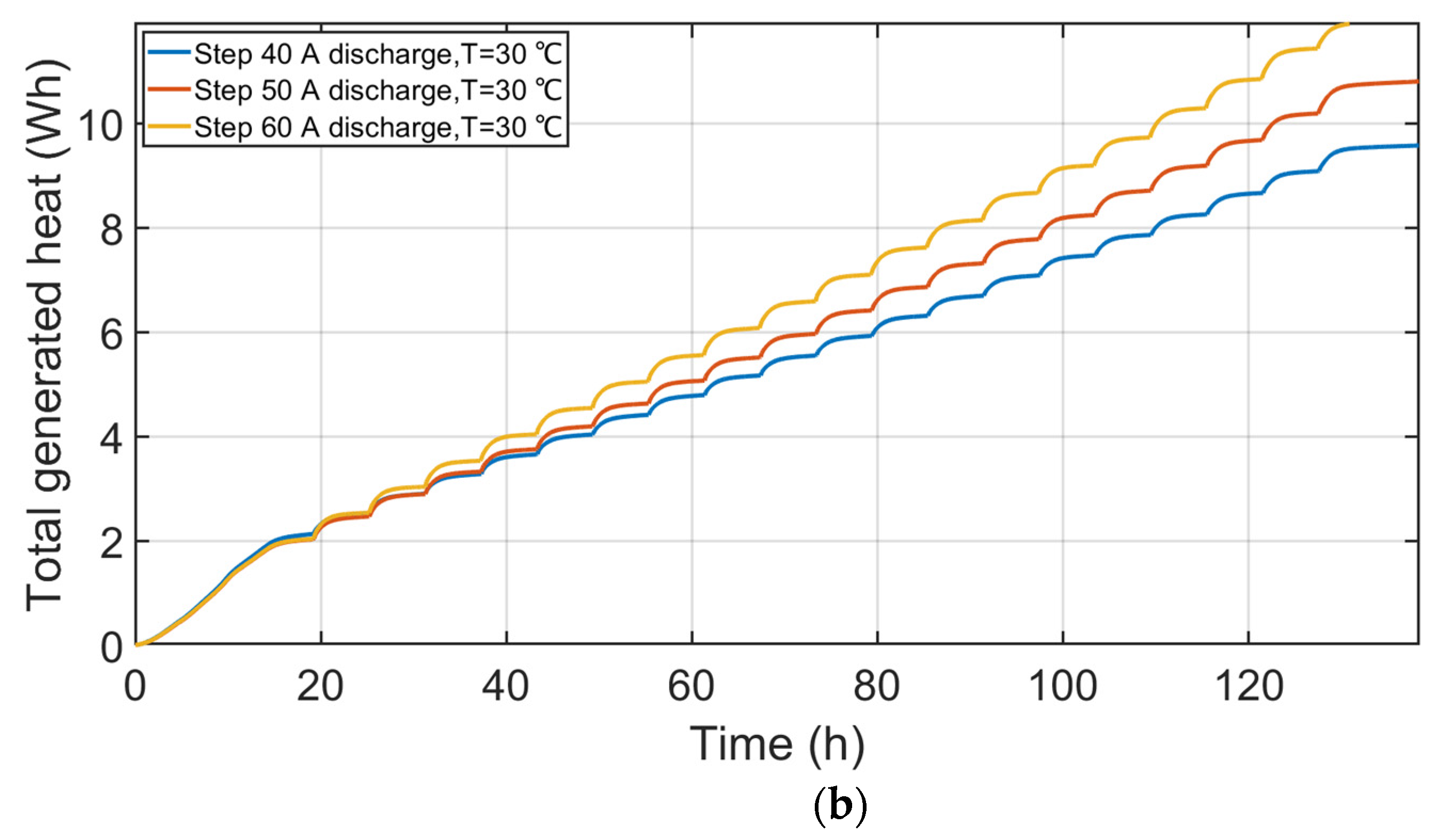
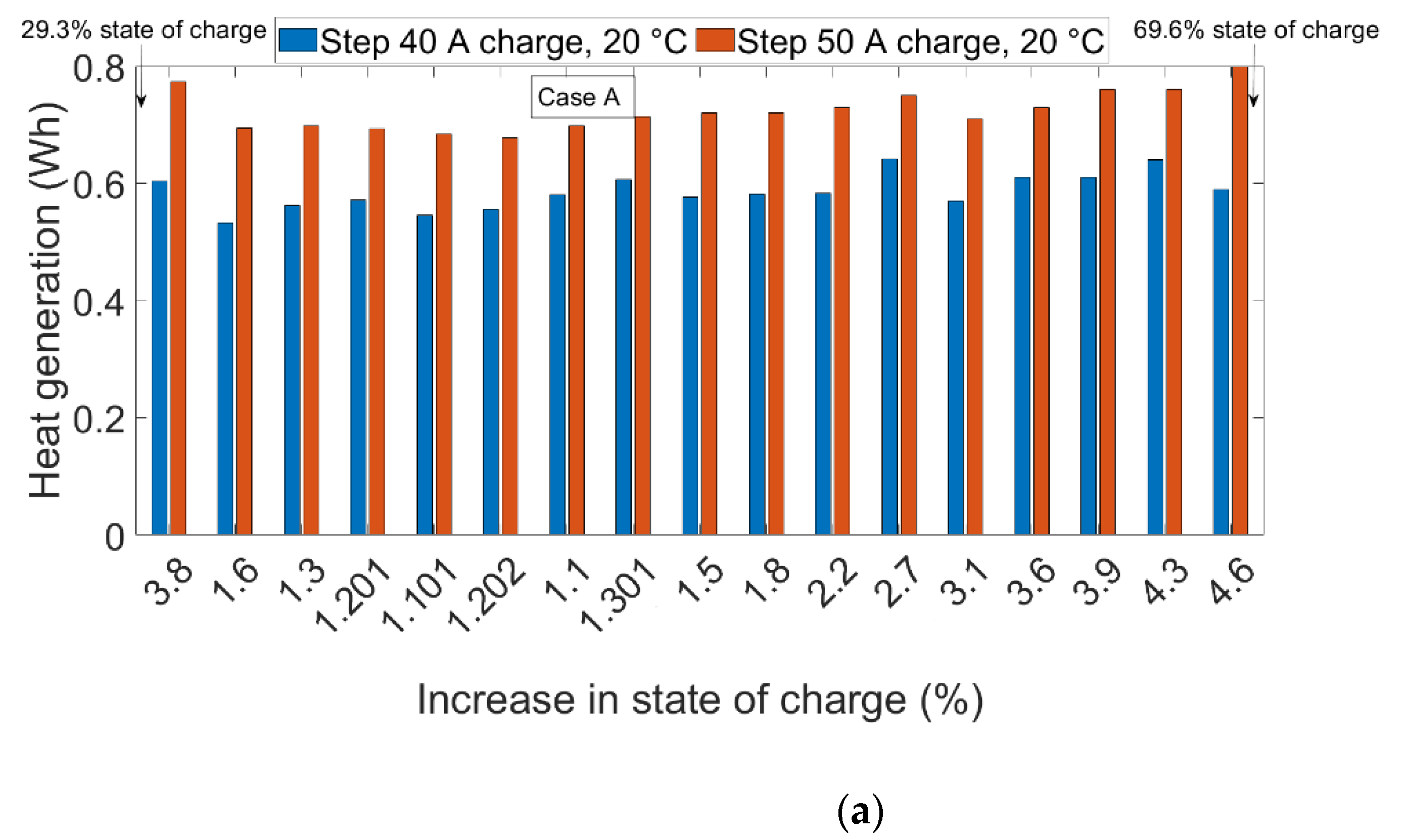

| Ref. | Investigation | Heat Generation Measurement Method | Battery Type | Discharge Rate | Highest Heat Generation |
|---|---|---|---|---|---|
| [35] | Electro-thermal model | Adiabatic calorimeter | LFP/graphite | 1 C, 3 C, 5 C | 1.17 W (1 C) 7.19 W (3 C) 17.95 W (5 C) |
| [36] | Thermal modeling of big cells | Adiabatic calorimeter | LCO/graphite | 1 C, 3 C, 5 C | 3.1 W (1 C) 14 W (3 C) 28 W (5 C) |
| [37] | Potentiometric and calorimetric measurement of entropy changes | Isoperibolic calorimeter | NMC/carbon | 0.5 C, 1 C, 1.5 C | 0.332 kJ (0.5 C) 0.798 kJ (1 C) 1.485 kJ (1.5 C) |
| [38] | Heat generation in high power battery | Adiabatic calorimeter | NMC/graphite | 1 C, 2 C | 11 W (1 C) 33 W (2 C) |
| [39] | Theoretical and experimental analysis of heat generations | Isothermal calorimeter | LMO/carbon | 4.1 C, 5 C, 5.7 C, 6.3 C,7 C | 15 W (4.1 C) 22 W (5 C) 30 W (5.7 C) 35 W (6.3 C) 40 W (7 C) |
| [40] | Thermal characteristics | Temperature sensors and an aluminum heat sink | LixMn2O4 Spinel | 0.1 C, 0.2 C, 0.33 C, 1 C | 0.82 W/L (0.1 C–0.2 C) 0.97 W/L (0.2 C–0.5 C) 3.21 W/L (0.5 C–1 C) |
| [41] | Characterization using electrochemical–calorimetric measurements | Accelerated rate calorimeter | Li-ion batteries | 0.1 C, 0.33 C | 0.26 W/L |
| [42] | Electrochemical-calorimetric studies | Accelerated rate calorimeter | cylindrical Li-ion battery | 0.33 C, 0.5 C, 1 C | 1.63 W/L |
| Current | Cut-Off Voltage | State of Charge | Heat Generation | Current | Cut-Off Voltage | State of Charge | Heat Generation |
|---|---|---|---|---|---|---|---|
| 3.25 A-CCC | 1.500 | 0 | 2.368 | 3.25 A-CCD | 2.543 | 90.820 | 3.791 |
| 3.25 A-CCD | 2.800 | 100 | 3.25 A-CCC | 1.500 | 0 | ||
| 3.25 A-CCC | 1.500 | 0 | 3.25 A-CCD | 2.800 | 100 | ||
| 40 A-PC | 2.093 | 29.300 | 0.790 | 3.25 A-CCC | 1.500 | 0 | |
| 40 A-PC | 2.131 | 33.100 | 0.604 | 50 A-PC | 2.093 | 29.300 | 1.109 |
| 40 A-PC | 2.147 | 34.700 | 0.533 | 50 A-PC | 2.131 | 33.100 | 0.774 |
| 40 A-PC | 2.160 | 36 | 0.563 | 50 A-PC | 2.147 | 34.700 | 0.695 |
| 40 A-PC | 2.172 | 37.200 | 0.571 | 50 A-PC | 2.160 | 36 | 0.698 |
| 40 A-PC | 2.183 | 38.300 | 0.545 | 50 A-PC | 2.172 | 37.200 | 0.693 |
| 40 A-PC | 2.195 | 39.500 | 0.556 | 50 A-PC | 2.183 | 38.300 | 0.684 |
| 40 A-PC | 2.206 | 40.600 | 0.580 | 50 A-PC | 2.195 | 39.500 | 0.678 |
| 40 A-PC | 2.219 | 41.900 | 0.606 | 50 A-PC | 2.206 | 40.600 | 0.698 |
| 40 A-PC | 2.234 | 43.400 | 0.577 | 50 A-PC | 2.219 | 41.900 | 0.714 |
| 40 A-PC | 2.252 | 45.200 | 0.582 | 50 A-PC | 2.234 | 43.400 | 0.720 |
| 40 A-PC | 2.274 | 47.400 | 0.583 | 50 A-PC | 2.252 | 45.200 | 0.720 |
| 40 A-PC | 2.301 | 50.100 | 0.642 | 50 A-PC | 2.274 | 47.400 | 0.730 |
| 40 A-PC | 2.332 | 53.200 | 0.570 | 50 A-PC | 2.301 | 50.100 | 0.750 |
| 40 A-PC | 2.368 | 56.800 | 0.610 | 50 A-PC | 2.332 | 53.200 | 0.710 |
| 40 A-PC | 2.407 | 60.700 | 0.610 | 50 A-PC | 2.368 | 56.800 | 0.730 |
| 40 A-PC | 2.450 | 65 | 0.640 | 50 A-PC | 2.407 | 60.700 | 0.760 |
| 40 A-PC | 2.496 | 69.600 | 0.590 | 50 A-PC | 2.450 | 65 | 0.760 |
| 40 A-PC | 2.543 | 74.300 | - | 50 A-PC | 2.496 | 69.600 | 0.800 |
| Current | Cut-Off Voltage | State of Charge | Heat Generation | Current | Heat Generation | Current | Heat Generation |
|---|---|---|---|---|---|---|---|
| 3.25 A-CCC | 2.264 | 80.86 | 2.524 | 3.25 A-CCD | 3.044 | 3.25 A-CCD | 2.459 |
| 3.25 A-CCD | 2.800 | 100 | 3.25 A-CCD | 3.25 A-CCD | |||
| 3.25 A-CCC | 1.500 | 0 | 3.25 A-CCC | 3.25 A-CCC | |||
| 3.25 A-CCD | 2.534 | 90.50 | 3.25 A-CCD | 3.25 A-CCD | |||
| 13 A-PD | 2.482 | 88.64 | 0.194 | 40 A-PD | 0.676 | 100 A-PD | 1.038 |
| 13 A-PD | 2.436 | 87.00 | 0.231 | 40 A-PD | 0.654 | 100 A-PD | 1.071 |
| 13 A-PD | 2.394 | 85.50 | 0.206 | 40 A-PD | 0.645 | 100 A-PD | 1.071 |
| 13 A-PD | 2.355 | 84.11 | 0.166 | 40 A-PD | 0.632 | 100 A-PD | 1.020 |
| 13 A-PD | 2.320 | 82.86 | 0.179 | 40 A-PD | 0.633 | 100 A-PD | 1.009 |
| 13 A-PD | 2.290 | 81.79 | 0.194 | 40 A-PD | 0.608 | 100 A-PD | 1.003 |
| 13 A-PD | 2.263 | 80.82 | 0.194 | 40 A-PD | 0.618 | 100 A-PD | 0.987 |
| 13 A-PD | 2.242 | 80.07 | 0.141 | 40 A-PD | 0.613 | 100 A-PD | 0.982 |
| 13 A-PD | 2.225 | 79.46 | 0.103 | 40 A-PD | 0.587 | 100 A-PD | 0.960 |
| 13 A-PD | 2.210 | 78.93 | 0.152 | 40 A-PD | 0.653 | 100 A-PD | 1 |
| 13 A-PD | 2.198 | 78.50 | 0.172 | 40 A-PD | 0.697 | 100 A-PD | 1.030 |
| 13 A-PD | 2.186 | 78.07 | 0.098 | 40 A-PD | 0.670 | 100 A-PD | 0.990 |
| 13 A-PD | 2.175 | 77.68 | 0.113 | 40 A-PD | 0.660 | 100 A-PD | 1 |
| 13 A-PD | 2.164 | 77.29 | 0.201 | 40 A-PD | 0.720 | 100 A-PD | 1.120 |
| 13 A-PD | 2.151 | 76.82 | 0.205 | 40 A-PD | 0.720 | 100 A-PD | 1.130 |
| 13 A-PD | 2.138 | 76.36 | 0.181 | 40 A-PD | 0.710 | 100 A-PD | 0.850 |
| 13 A-PD | 2.121 | 75.75 | 0.132 | 40 A-PD | 0.770 | 100 A-PD | 0.620 |
| Current | Cut-Off Voltage | State of Charge | Heat Generation | Current | Heat Generation | Current | Heat Generation |
|---|---|---|---|---|---|---|---|
| 3.25 A-CCC | 2.077 | 74.18 | 2.131 | 3.25 A-CCC | 2.026 | 3.25 A-CCC | 2.037 |
| 3.25 A-CCD | 2.800 | 100 | 3.25 A-CCD | 3.25 A-CCD | |||
| 3.25 A-CCC | 1.500 | 0 | 3.25 A-CCC | 3.25 A-CCC | |||
| 3.25 A-CCD | 2.800 | 100 | 3.25 A-CCD | 3.25 A-CCD | |||
| 40 A-PD | 2.532 | 90.43 | 0.396 | 50 A-PD | 0.437 | 60 A-PD | 0.498 |
| 40 A-PD | 2.480 | 88.57 | 0.375 | 50 A-PD | 0.431 | 60 A-PD | 0.499 |
| 40 A-PD | 2.434 | 86.93 | 0.393 | 50 A-PD | 0.428 | 60 A-PD | 0.500 |
| 40 A-PD | 2.392 | 85.43 | 0.360 | 50 A-PD | 0.428 | 60 A-PD | 0.507 |
| 40 A-PD | 2.352 | 84.00 | 0.379 | 50 A-PD | 0.457 | 60 A-PD | 0.502 |
| 40 A-PD | 2.318 | 82.79 | 0.377 | 50 A-PD | 0.422 | 60 A-PD | 0.506 |
| 40 A-PD | 2.287 | 81.68 | 0.381 | 50 A-PD | 0.441 | 60 A-PD | 0.509 |
| 40 A-PD | 2.262 | 80.79 | 0.376 | 50 A-PD | 0.442 | 60 A-PD | 0.518 |
| 40 A-PD | 2.241 | 80.04 | 0.381 | 50 A-PD | 0.452 | 60 A-PD | 0.514 |
| 40 A-PD | 2.223 | 79.39 | 0.379 | 50 A-PD | 0.452 | 60 A-PD | 0.509 |
| 40 A-PD | 2.209 | 78.89 | 0.384 | 50 A-PD | 0.445 | 60 A-PD | 0.521 |
| 40 A-PD | 2.196 | 78.43 | 0.383 | 50 A-PD | 0.457 | 60 A-PD | 0.527 |
| 40 A-PD | 2.185 | 78.04 | 0.391 | 50 A-PD | 0.462 | 60 A-PD | 0.538 |
| 40 A-PD | 2.174 | 77.64 | 0.387 | 50 A-PD | 0.469 | 60 A-PD | 0.512 |
| 40 A-PD | 2.162 | 77.21 | 0.387 | 50 A-PD | 0.460 | 60 A-PD | 0.536 |
| 40 A-PD | 2.150 | 76.79 | 0.394 | 50 A-PD | 0.482 | 60 A-PD | 0.557 |
| 40 A-PD | 2.136 | 76.29 | 0.412 | 50 A-PD | 0.492 | 60 A-PD | 0.560 |
| 40 A-PD | 2.119 | 75.68 | 0.416 | 50 A-PD | 0.507 | 60 A-PD | 0.590 |
| Step 40 A Charge, 20 °C | Step 50 A Charge, 20 °C | Step 13 A Discharge, 20 °C | Step 40 A Discharge, 20 °C | Step 100 A Discharge, 20 °C | Step 40 A Discharge, 30 °C | Step 50 A Discharge, 30 °C | Step 60 A Discharge, 30 °C | |
|---|---|---|---|---|---|---|---|---|
| A1 | 5.33 × 107 | 6.20 × 107 | 2.35 × 107 | 5.86 × 107 | 6.82 × 107 | 3.57× 107 | 3.89 × 107 | 4.23 × 107 |
| B1 | 1.02 × 10−5 | 1.02 × 10−5 | 7.28 × 10−6 | 6.09 × 10−6 | 6.18 × 10−6 | 6.09 × 10−6 | 5.80 × 10−6 | 6.31 × 10−6 |
| C1 | −0.4048 | −0.4048 | −0.4579 | −0.5172 | −0.3037 | −0.5144 | −0.4207 | −0.5416 |
| A2 | 1.90 × 107 | 1.90 × 107 | 9.22 × 106 | 2.27 × 107 | 2.53 × 107 | 1.35 × 107 | 1.48 × 107 | 1.61 × 107 |
| B2 | 2.00 × 10−5 | 2.00 × 10−5 | 1.45 × 10−5 | 1.23 × 10−5 | 1.19 × 10−5 | 1.22 × 10−5 | 1.14 × 10−5 | 1.26 × 10−5 |
| C2 | 1.67 | 1.67 | 1.022 | 1.254 | 2.049 | 1.241 | 1.606 | 1.265 |
| A3 | 2.73 × 10 6 | 2.73 × 106 | 1.64 × 106 | 3.75 × 106 | 4.68 × 106 | 2.20 × 106 | 2.56 × 106 | 2.86 × 106 |
| B3 | 3.93 × 10−5 | 3.93 × 10−5 | 2.93 × 10−5 | 2.40 × 10−5 | 2.30 × 10−5 | 2.44 × 10−5 | 2.20 × 10−5 | 2.52 × 10−5 |
| C3 | 2.409 | 2.409 | 0.7139 | 1.528 | 3.368 | 1.325 | 2.533 | 1.411 |
| A4 | 1.02 × 106 | 1.02 × 106 | 4.77 × 105 | 1.30 × 106 | 1.85 × 106 | 6.86 × 105 | 8.67 × 105 | 1.04 × 106 |
| B4 | 5.65 × 10−5 | 5.65 × 10−5 | 4.32 × 10−5 | 3.64 × 10−5 | 3.41 × 10−5 | 3.66 × 10−5 | 2.89 × 10−5 | 3.79 × 10−5 |
| C4 | 3.22 | 3.22 | 0.5231 | 1.568 | 4.465 | 1.396 | 4.56 | 1.515 |
| A5 | 7.44 × 105 | 7.44 × 105 | 1.33 × 105 | 4.84 × 105 | 9.23 × 105 | 2.46 × 105 | 3.62 × 105 | 4.72 × 105 |
| B5 | 8.29 × 10−5 | 8.29 × 10−5 | 7.60 × 10−5 | 4.81 × 10−5 | 4.22 × 10−5 | 4.88 × 10−5 | 4.32 × 10−5 | 5.05 × 10−5 |
| C5 | 2.418 | 2.418 | −1.847 | 1.748 | 6.012 | 1.605 | 4.945 | 1.651 |
| A6 | 6.54 × 105 | 6.54 × 105 | 1.21 × 105 | 2.72 × 105 | 6.44 × 105 | 1.93 × 105 | 2.02 × 105 | 3.04 × 105 |
| B6 | 9.86 × 10−5 | 9.86 × 10−5 | 0.000289 | 0.0002867 | 0.0002903 | 0.0002926 | 0.0002842 | 0.0002902 |
| C6 | 3.264 | 3.264 | 0.6368 | 0.9783 | 0.6488 | −2.78 | −0.3131 | −1.972 |
| A7 | 5.34 × 105 | 5.34 × 105 | 1.37 × 105 | 2.58 × 105 | 5.37 × 105 | 1.17 × 105 | 2.04 × 105 | 2.58 × 105 |
| B7 | 0.0001255 | 0.0001255 | 6.10 × 10−5 | 5.20 × 10−5 | 5.78 × 10−5 | 0.0002816 | 0.0002955 | 6.31 × 10−5 |
| C7 | 2.599 | 2.599 | −0.4557 | 3.89 | 5.666 | 0.7229 | 2.741 | 1.824 |
| A8 | 3.39 × 105 | 3.39 × 105 | 8.69 × 104 | 1.82 × 105 | 3.96 × 105 | 1.17 × 105 | 1.82 × 105 | 1.86 × 105 |
| B8 | 0.0001314 | 0.0001314 | 0.0001307 | 0.0002944 | 6.48 × 10−5 | 6.10 × 10−5 | 4.99 × 10−5 | 7.57 × 10−5 |
| C8 | 5.069 | 5.069 | 1.966 | −1.009 | 7.232 | 1.969 | 6.338 | 1.992 |
Publisher’s Note: MDPI stays neutral with regard to jurisdictional claims in published maps and institutional affiliations. |
© 2021 by the authors. Licensee MDPI, Basel, Switzerland. This article is an open access article distributed under the terms and conditions of the Creative Commons Attribution (CC BY) license (http://creativecommons.org/licenses/by/4.0/).
Share and Cite
Madani, S.S.; Schaltz, E.; Kær, S.K. Thermal Characterizations of a Lithium Titanate Oxide-Based Lithium-Ion Battery Focused on Random and Periodic Charge-Discharge Pulses. Appl. Syst. Innov. 2021, 4, 24. https://doi.org/10.3390/asi4020024
Madani SS, Schaltz E, Kær SK. Thermal Characterizations of a Lithium Titanate Oxide-Based Lithium-Ion Battery Focused on Random and Periodic Charge-Discharge Pulses. Applied System Innovation. 2021; 4(2):24. https://doi.org/10.3390/asi4020024
Chicago/Turabian StyleMadani, Seyed Saeed, Erik Schaltz, and Søren Knudsen Kær. 2021. "Thermal Characterizations of a Lithium Titanate Oxide-Based Lithium-Ion Battery Focused on Random and Periodic Charge-Discharge Pulses" Applied System Innovation 4, no. 2: 24. https://doi.org/10.3390/asi4020024
APA StyleMadani, S. S., Schaltz, E., & Kær, S. K. (2021). Thermal Characterizations of a Lithium Titanate Oxide-Based Lithium-Ion Battery Focused on Random and Periodic Charge-Discharge Pulses. Applied System Innovation, 4(2), 24. https://doi.org/10.3390/asi4020024








